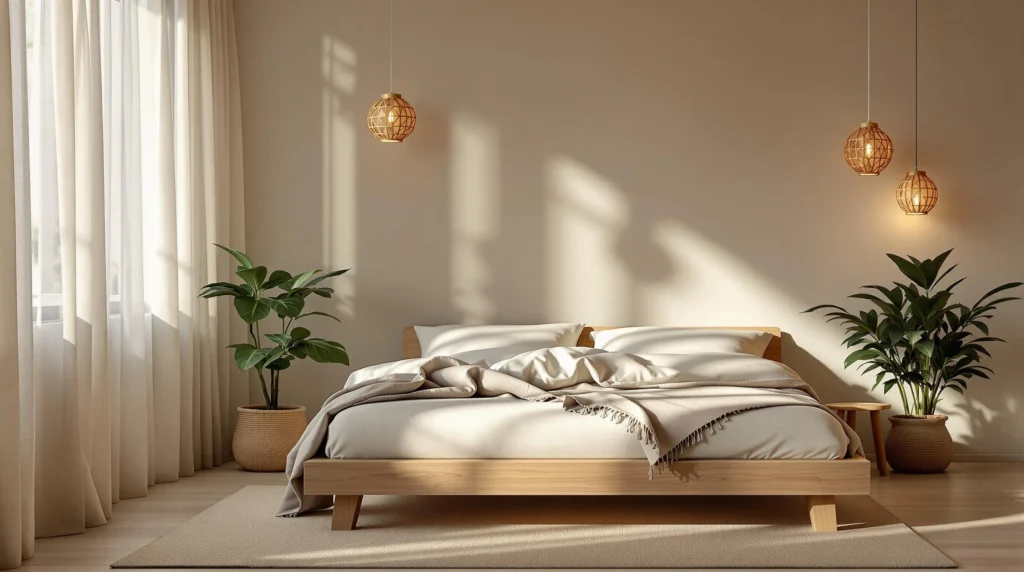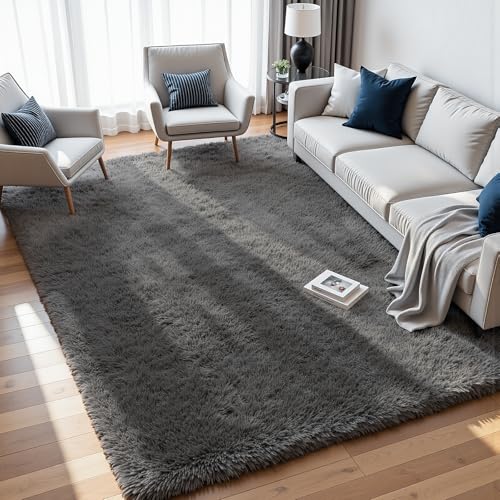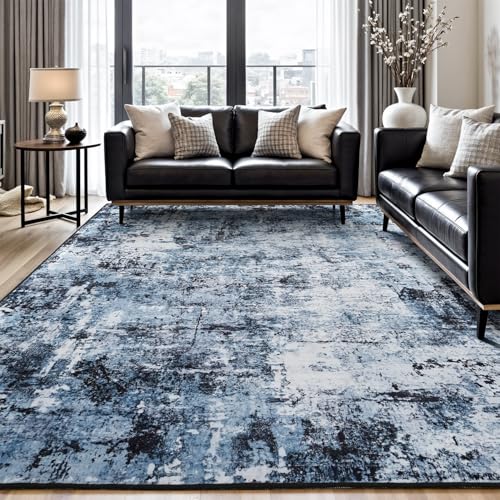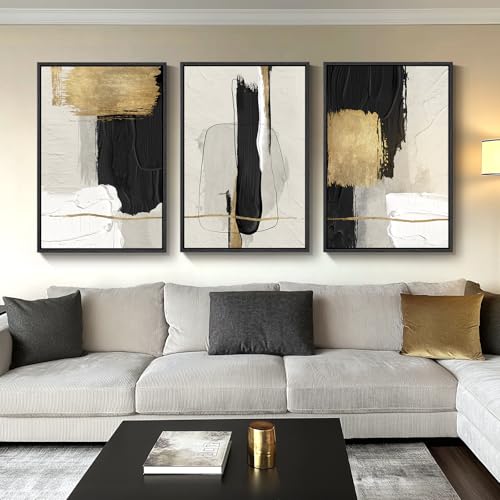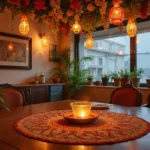Looking for a bedroom sanctuary that combines minimalist elegance with natural warmth? Japandi bedroom designs offer the perfect balance of Scandinavian functionality and Japanese simplicity. This harmonious fusion creates spaces that aren’t just beautiful—they’re genuinely peaceful retreats from our hectic lives.
We’ve explored how this trending style combines clean lines, neutral colors, and natural materials to transform ordinary bedrooms into havens of tranquility. The beauty of Japandi lies in its deliberate simplicity; every element serves both function and aesthetic purpose, eliminating clutter while embracing nature-inspired elements. From platform beds to bamboo accents, these designs prioritize both comfort and mindful living.
The Essence of Japandi: Where Japanese Minimalism Meets Scandinavian Comfort
Japandi design philosophy beautifully marries two distinct yet complementary aesthetics—Japanese minimalism and Scandinavian hygge. This fusion creates spaces that are both functionally streamlined and comfortably cozy, perfect for the bedroom where relaxation is paramount. The core principles focus on simplicity, natural elements, and thoughtful curation of items.
Japanese design contributes the concept of “wabi-sabi,” embracing imperfection and transience through weathered woods, handcrafted ceramics, and asymmetrical arrangements. Meanwhile, Scandinavian influences bring warmth through soft textiles, gentle curves, and practical furniture designs that prioritize comfort without sacrificing style.
In Japandi bedrooms, you’ll find a careful balance between these elements—neutral color palettes featuring earthy tones like stone, sand, and muted greens that create a calming atmosphere. Natural materials dominate every aspect, from wooden bed frames to linen bedding and rattan light fixtures, connecting the space to the natural industry.
The furniture in Japandi spaces follows the “less is more” principle, with each piece serving both functional and aesthetic purposes. Low-profile platform beds, minimalist nightstands, and streamlined storage answers showcase clean lines and exceptional craftsmanship. These pieces often feature rounded edges and organic shapes that soften the overall geometric precision.
Negative space plays a crucial role in Japandi design, allowing rooms to breathe and creating visual calm. Rather than filling every corner, we celebrate emptiness as an intentional design choice that reduces visual noise and promotes mindfulness. This approach transforms bedrooms into sanctuaries where both body and mind can truly rest.
Creating a Neutral Color Palette for Your Japandi Bedroom Retreat

When designing a Japandi bedroom, the color palette serves as the foundation for creating a tranquil space. Warm, neutral tones form the cornerstone of this aesthetic, promoting both visual harmony and emotional calm while honoring the minimalist principles central to both Japanese and Scandinavian design philosophies.
Earthy Tones That Soothe the Senses
The Japandi style embraces a rich spectrum of earth-inspired colors that naturally calm the mind and body. Clay, taupe, and sand tones create an organic serenity that connects your bedroom to the natural industry. We recommend incorporating natural wood elements such as oak or bamboo furniture pieces that add warmth without disrupting the clean aesthetic. Rattan accessories introduce subtle visual interest while maintaining the earthy theme essential to Japandi design. Off-white or cream accents work wonderfully to enhance the overall sense of visual calmness, creating breathing space between darker elements. These natural color choices avoid high-contrast combinations that might disrupt the harmonious atmosphere you’re aiming to achieve.
Incorporating Subtle Texture Through Color Variations
Texture plays a crucial role in preventing neutral Japandi bedrooms from feeling flat or uninspiring. Materials like linen, wool, and woven textiles in similar tonal ranges add tactile depth without introducing competing colors. Try layering a beige linen duvet over stone-gray sheets for a sophisticated yet subtle contrast that maintains visual cohesion. Under-bed area rugs in soft grays or muted earthy hues help anchor your space while contributing to the overall color story. Natural wood grains visible in furniture pieces provide inherent texture that adds character without overwhelming the minimalist aesthetic. Woven baskets or subtle patterns featuring organic brushstrokes can introduce dimensional interest while honoring the understated Japandi approach to decoration. These thoughtful texture variations create visual richness even within a limited color palette.
Minimalist Furniture Choices for the Perfect Japandi Bedroom

The furniture you select forms the foundation of any successful Japandi bedroom design. These pieces must balance form and function while maintaining the clean, uncluttered aesthetic that defines this harmonious style.
Low-Profile Bed Frames That Embody Zen Aesthetics
Low-profile bed frames serve as the centerpiece of Japandi bedroom design, creating a grounded, peaceful atmosphere that honors Japanese design principles. Angular wooden frames featuring sharp, geometric lines paired with light wood finishes perfectly capture the Japandi balance of modern simplicity and organic warmth. These structures typically sit close to the floor, improving the Zen-inspired feeling of being connected to the earth. Oak and ash woods are particularly effective choices, offering natural texture while maintaining the essential visual lightness that prevents the space from feeling heavy. Platform beds with minimal ornamentation exemplify this aesthetic, providing a serene focal point that anchors the entire room without overwhelming it.
Streamlined Storage Answers to Maintain Clutter-Free Spaces
Concealed storage options play a critical role in maintaining the clutter-free environment essential to Japandi design philosophy. Built-in wardrobes with simple facades eliminate visual noise while maximizing functional space in the bedroom. Under-bed drawers use otherwise wasted space, keeping possessions accessible yet hidden from view. Multipurpose furniture pieces, such as benches with hidden compartments, honor the Scandinavian commitment to practicality while preserving minimalist aesthetics. Neutral-toned rattan baskets and linen-covered storage boxes offer versatile answers that complement the natural material palette. These thoughtfully designed storage elements allow personal items to remain organized and out of sight, creating the serene, uncluttered atmosphere that makes Japandi bedrooms such peaceful retreats for rest and rejuvenation.
Natural Materials: The Foundation of Relaxing Japandi Bedroom Designs
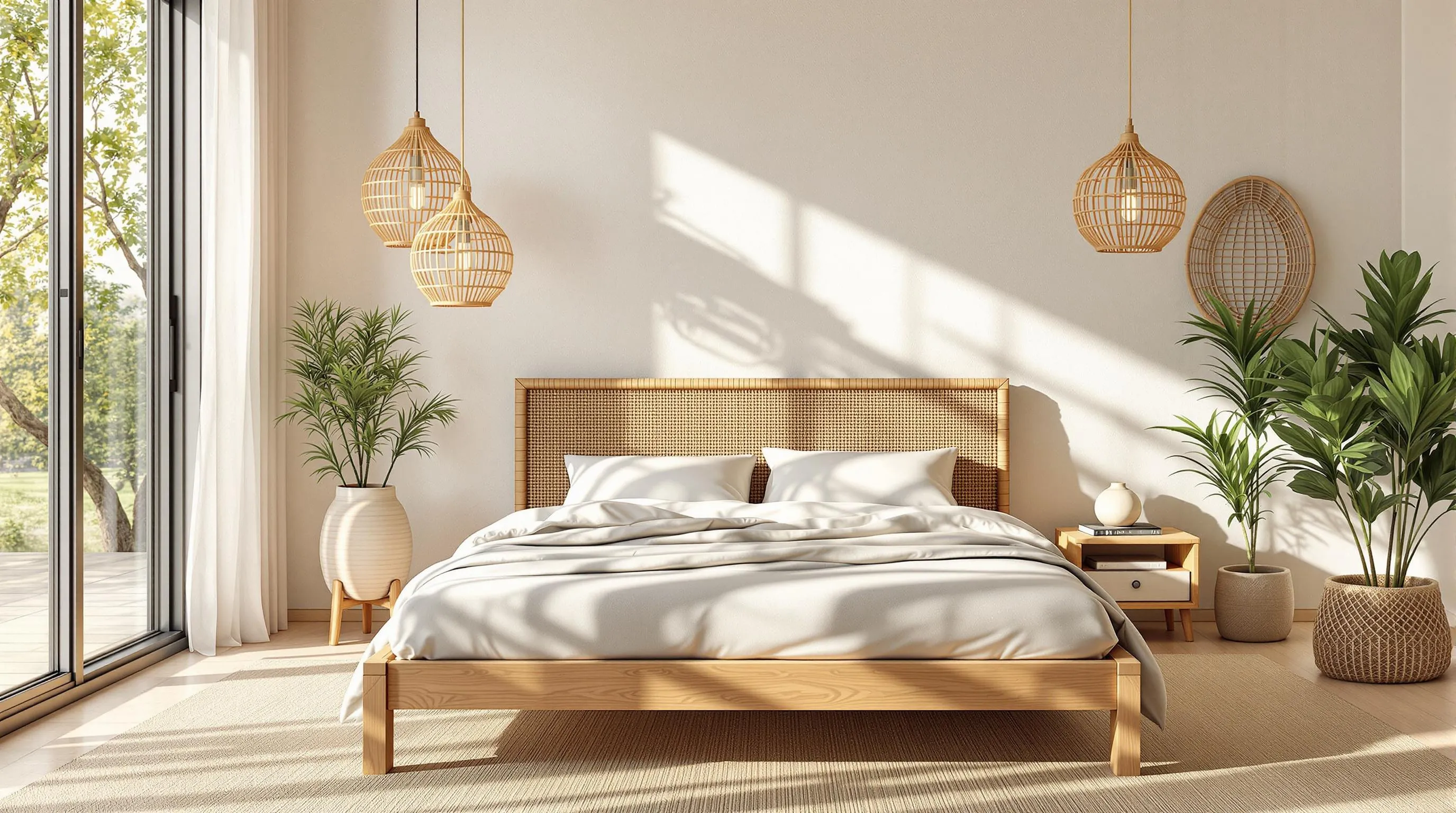
Natural materials serve as the cornerstone of authentic Japandi bedroom design, creating spaces that feel organically connected to the earth while promoting tranquility and rest.
Embracing Unfinished Wood Elements
Unfinished wood elements bring undeniable warmth and authenticity to Japandi bedrooms, serving as primary design anchors that ground the entire space. Clean-lined wooden bed frames showcase the material’s natural grain and texture, creating an immediate connection to nature that promotes relaxation. The raw, honest quality of unfinished wood perfectly embodies the Japandi philosophy of simplicity and appreciation for natural beauty. Many designers recommend oak, walnut, or maple for their distinctive character and durability in bedroom furniture pieces. These wooden elements effectively bridge the outdoors and indoors, establishing a soothing environment that encourages restful sleep and mindful living. Furniture with visible wood grain patterns adds visual interest without overwhelming the space, maintaining the balanced aesthetic that makes Japandi so appealing for bedroom designs.
Incorporating Bamboo, Rattan and Other Sustainable Materials
Sustainable materials like bamboo and rattan offer both ecological benefits and design versatility in Japandi bedroom settings. These materials introduce organic texture and visual lightness while maintaining the style’s commitment to environmental consciousness. Bamboo headboards provide a striking yet minimalist focal point, complementing the room’s neutral palette with their natural golden hues. Rattan pendant lights cast gentle shadows that enhance the room’s peaceful ambiance during evening hours. Woven storage baskets made from these sustainable materials combine functionality with aesthetic appeal, keeping clutter contained while adding textural contrast. Sustainable material choices reflect the Japandi principle of mindful consumption, where quality and longevity take precedence over disposable trends. These elements help maintain the inviting yet minimalist atmosphere that defines successful Japandi spaces, creating bedrooms that feel both thoughtfully designed and effortlessly natural.
Thoughtful Lighting Design for Your Japandi Sanctuary

Lighting plays a crucial role in creating the perfect Japandi bedroom atmosphere, balancing function with aesthetic harmony while maintaining the serene ambiance essential to this design philosophy.
Paper Lanterns and Pendant Lights
Paper lanterns serve as ideal lighting fixtures in Japandi bedrooms, diffusing light through natural materials to create a warm, inviting glow. These traditional Japanese elements pair beautifully with Scandinavian simplicity, casting soft shadows that enhance the room’s peaceful character. Pendant lights with clean, minimalist designs offer another excellent lighting option, hanging elegantly above bedside tables or in corners to provide focused illumination without visual clutter. The angular silhouettes of modern pendant fixtures complement the geometric elements often found in Japandi furniture while maintaining an unobtrusive presence. We recommend selecting pendant lights crafted from natural materials like wood, bamboo, or paper to reinforce the organic aesthetic that defines this style. Both lighting options contribute significantly to the room’s tranquil atmosphere, creating gentle pools of light that invite relaxation and mindfulness.
Maximizing Natural Light Through Strategic Window Treatments
Natural light forms the foundation of authentic Japandi bedroom illumination, connecting interior spaces with the outdoors while improving the room’s serene quality. Strategic window treatments allow you to control light flow throughout the day, creating different moods and atmospheres. Sheer linen curtains filter harsh sunlight into a soft, diffused glow that highlights the natural textures and neutral tones throughout the space. Bamboo blinds offer another excellent option, providing privacy while still allowing dappled light to enter, creating interesting shadow patterns that add subtle visual interest. For bedrooms with limited natural light, positioning mirrors across from windows multiplies available daylight, brightening the space while maintaining the minimalist aesthetic. Floor-to-ceiling curtains in neutral tones can frame windows beautifully, drawing the eye upward and creating an illusion of higher ceilings without adding visual weight. These thoughtful approaches to window treatments ensure your Japandi bedroom remains bathed in natural illumination that showcases its carefully curated elements while promoting a sense of calm and connection to nature.
Introducing Biophilic Elements to Enhance Tranquility
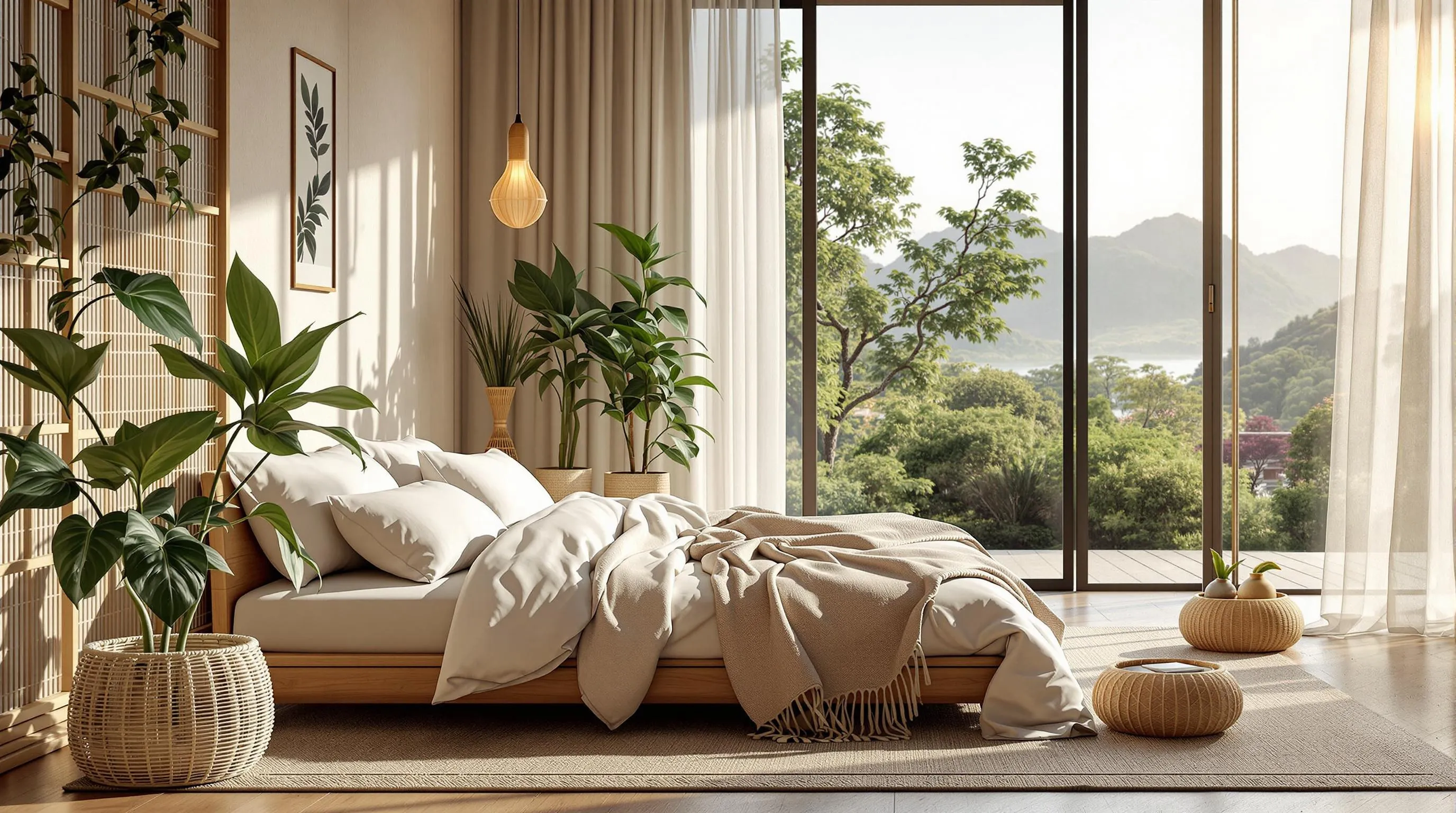
Embracing biophilic design principles elevates Japandi bedrooms by deepening the connection to nature and improving overall tranquility. Incorporating organic textures like woven rattan, bamboo, or clay introduces tactile dimension while maintaining minimalist aesthetics. Nature-inspired artwork depicting serene landscapes or botanical themes evokes calmness without introducing clutter. Stone lamps and bamboo blinds serve as subtle natural references that honor both Japanese and Scandinavian design traditions.
Indoor Plants That Thrive in Japandi Bedrooms
Low-maintenance plants perfectly complement the minimalist Japandi aesthetic while purifying air and improving well-being. Snake plants with their striking vertical lines create architectural interest and require minimal care, thriving in the indirect light typical of bedrooms. Peace lilies offer elegant white blooms against glossy green leaves, adding a touch of refined natural beauty without overwhelming the space. ZZ plants feature deep green, waxy foliage that adds a sophisticated yet understated element to bedside tables or floor planters. Potted bonsai trees serve as living sculptures that embody the Japanese appreciation for meticulous care and intentional growth. Air plants displayed in simple ceramic holders require no soil, providing versatile placement options that maintain the clean, uncluttered look essential to Japandi design.
Natural Views and Connections to Outdoor Spaces
Maximizing natural light stands as a cornerstone principle in Japandi bedroom design, creating spaces that feel expansive and connected to the outdoors. Sheer linen curtains filter sunlight beautifully, bathing rooms in soft, diffused illumination while maintaining privacy. Positioning beds or seating areas strategically near windows frames outdoor views, transforming natural landscapes into living artwork that changes with the seasons. Sliding Shoji-inspired panels offer flexible room division while allowing light to penetrate deeper into interior spaces. Large glass doors blur the boundaries between indoor and outdoor environments, extending the visual space of the bedroom and improving spatial harmony. Window treatments that retract completely during daylight hours maximize the connection to nature, supporting the biophilic principles that underpin truly restorative Japandi bedroom designs.
Textiles and Bedding That Blend Japanese Simplicity with Nordic Coziness
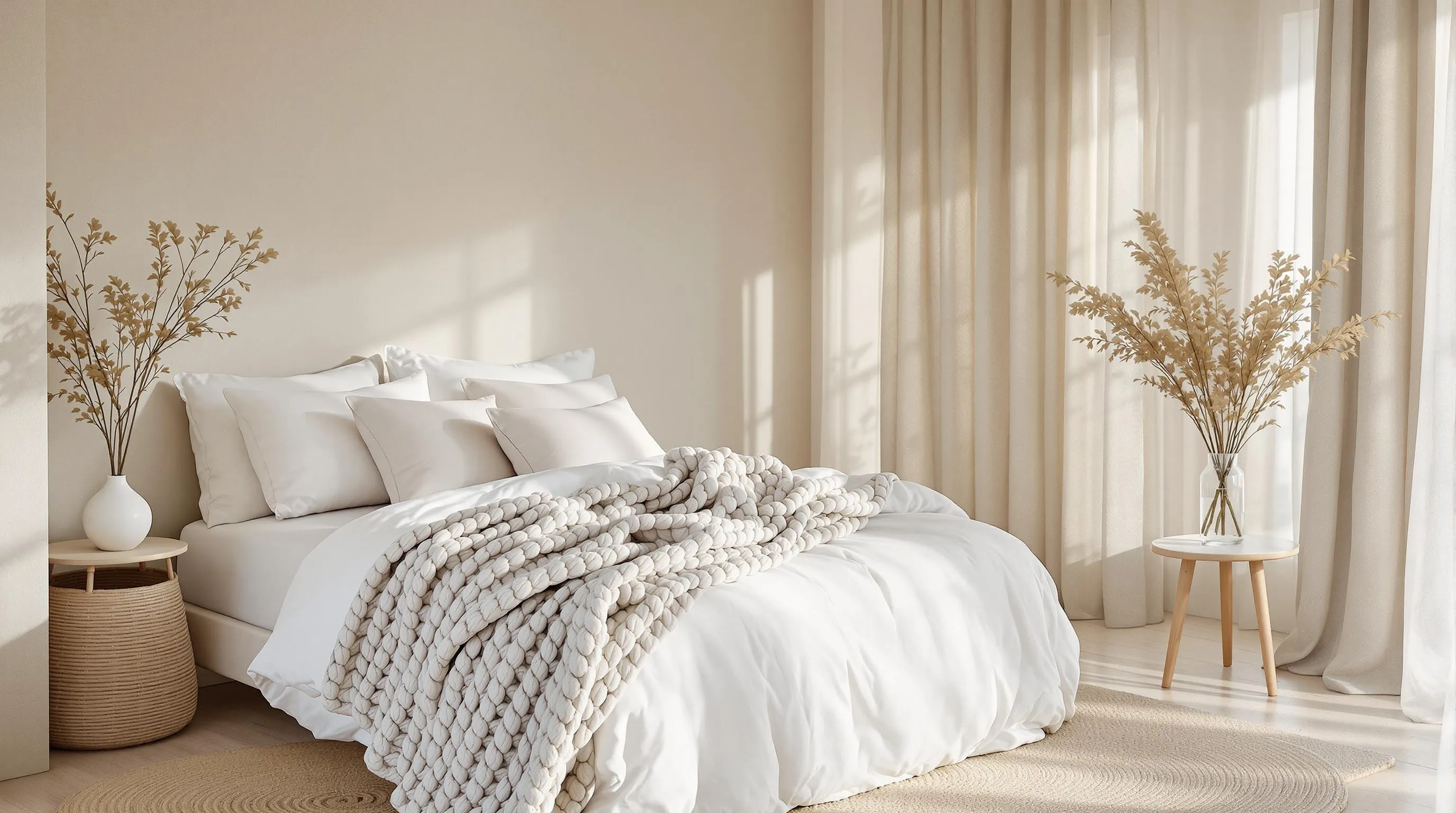
The cornerstone of every successful Japandi bedroom lies in its thoughtfully selected textiles and bedding. Natural materials and muted tones create the perfect foundation for a space that embodies both Japanese minimalism and Scandinavian warmth.
Selecting Linen and Cotton Bedding for Texture and Comfort
Linen bedding offers exceptional breathability and a distinctive crispness that perfectly complements the Japandi aesthetic. Its natural texture adds visual interest while maintaining the minimalist approach essential to this design style. Cotton alternatives provide similar benefits with added warmth, making them ideal for cooler months or those who prefer a smoother feel against their skin. Both materials feature cooling properties that promote better sleep quality, aligning with the Japandi focus on wellness and comfort. High-quality natural fibers in whites, creams, and soft neutrals help maintain the serene atmosphere characteristic of this design approach. These textiles age beautifully over time, developing a lived-in patina that celebrates the Japanese wabi-sabi philosophy of finding beauty in imperfection.
The Art of Layering Without Creating Visual Clutter
Mastering thoughtful layering allows for comfort without compromising the clean aesthetic central to Japandi design. Incorporate pillows in varying sizes and shapes, including rectangular and round bolster options, arranged with intentional asymmetry for visual balance. Add a single chunky knit throw blanket casually draped across the foot of the bed to introduce texture and warmth without overwhelming the space. Soft, sheer curtains filtered with natural light can be layered with simple bamboo blinds, providing both privacy and textural interest through the contrast of materials. Area rugs made from natural fibers like jute or wool ground the space while adding another layer of texture beneath your feet. Select pieces featuring subtle geometric patterns or nature-inspired motifs to enhance tranquility without introducing busy visual elements. This strategic layering creates depth and dimension while maintaining the simplified, uncluttered environment that makes Japandi bedrooms such peaceful retreats.
Mindful Decor: Curating Meaningful Objects for Your Japandi Bedroom

Japandi bedrooms thrive on thoughtful minimalism, where each object serves both purpose and aesthetic value. The essence of this design philosophy lies in selecting functional items that enhance serenity rather than creating visual noise.
The Power of Negative Space in Japanese-Inspired Design
Negative space forms the foundation of Japanese-inspired design, allowing each element in your bedroom to truly “breathe.” This intentional emptiness, known as ma (間) in Japanese tradition, creates a sense of calm that’s essential for a restful bedroom environment. We recommend keeping surfaces clean and furniture arrangements sparse to maintain balanced proportions and uncluttered sightlines throughout the space. Focus on symmetry when positioning the few elements you choose to include, such as a low-profile bed with streamlined bedding that doesn’t overwhelm the room. Limiting decor to true essentials prevents visual fatigue and promotes better sleep quality. Consider a single focal piece, like oversized wall art or a statement pendant light, that can anchor the space without disrupting its peaceful flow.
Choosing Quality Over Quantity with Handcrafted Accessories
Artisanal items that blend Scandinavian craftsmanship with Japanese precision offer lasting beauty that mass-produced alternatives simply can’t match. We suggest incorporating natural textile elements like linen throws or cushions that add subtle texture while maintaining the neutral color palette essential to Japandi style. Hand-thrown pottery pieces can serve as both functional containers and artistic expressions, particularly when featuring organic shapes and earthy glazes. Durable materials such as jute, wool, and bamboo connect your space to nature while promising to age gracefully over time. Woven baskets offer practical storage answers that double as textural elements, helping maintain the clutter-free environment. Select just one or two handcrafted statement pieces—perhaps a wooden sculpture or ceramic vase—that reflect personal meaning rather than filling shelves with meaningless objects. This curated approach ensures each item in your Japandi bedroom tells a story while contributing to the space’s overall serenity.
Creating a Relaxing Japandi Bedroom in Small Spaces

Small spaces require thoughtful design approaches, and Japandi style offers the perfect solution with its emphasis on minimalism and functionality. We’ve gathered essential strategies to help you create a serene Japandi retreat regardless of your bedroom’s dimensions.
Essential Elements of Japandi Design
- Minimalism is crucial for small Japandi bedrooms. Remove all unnecessary items and keep only essentials to maintain openness and create the illusion of more space. This deliberate reduction of clutter instantly makes any small room feel more expansive and peaceful.
- Natural materials bring warmth and authenticity to compact spaces. Incorporate wood, bamboo, stone, and linen elements throughout your bedroom to create an organic feel without overwhelming the limited square footage.
- Neutral color palettes expand visual space in small Japandi bedrooms. Focus on whites, creams, grays, and earthy tones to create a serene atmosphere that makes walls recede and ceilings appear higher.
- Natural light maximization transforms cramped spaces. Install sheer curtains or simple blinds that allow sunlight to filter through while maintaining privacy, instantly making your small bedroom feel airier and more connected to the outdoors.
Design Tips for Small Spaces
- Layered lighting options create dimension without consuming valuable floor space. Combine soft ceiling fixtures with compact table lamps to enhance ambiance while keeping surfaces clear of bulky lighting answers.
- Textured elements add depth to minimal spaces without requiring additional items. Incorporate chunky throw blankets and natural fiber rugs strategically to create visual interest that doesn’t overwhelm your small bedroom.
- Functional furniture selections eliminate wasted space in compact Japandi bedrooms. Choose pieces that serve dual purposes, such as platform beds with built-in storage or floating nightstands that free up floor area.
- Visual interest through varying pillow sizes creates focal points without cluttering the space. Arrange differently shaped cushions in complementary neutral tones to add dimension to your bed while maintaining the clean Japandi aesthetic.
Implementing these focused elements allows you to enjoy the calming benefits of Japandi design even in the smallest of bedrooms, creating a perfectly balanced sanctuary that feels both spacious and serene.
Incorporating Sustainable Practices in Your Japandi Bedroom Design
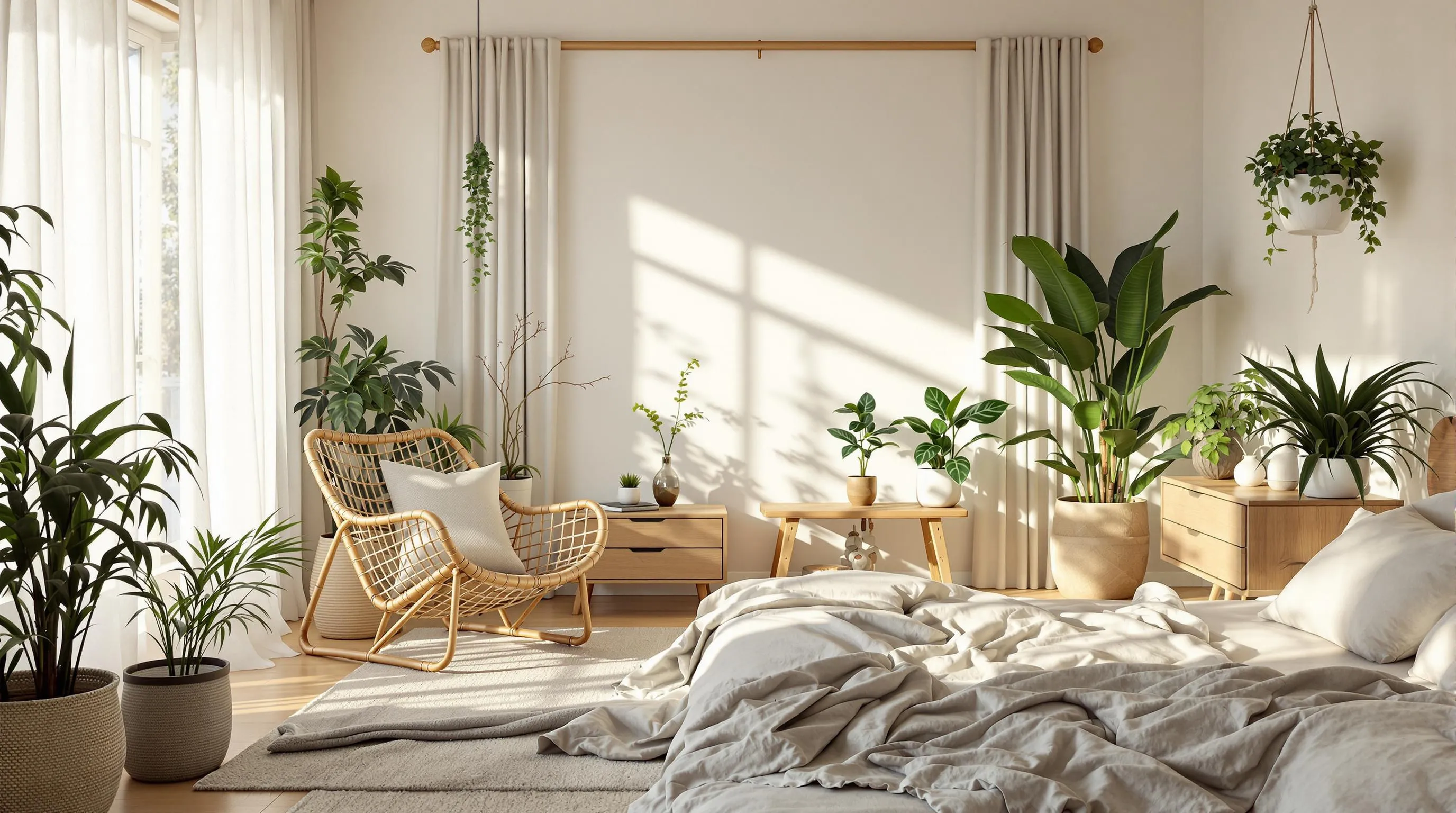
The Japandi aesthetic naturally aligns with eco-conscious living through its emphasis on simplicity and quality. We can enhance this inherent sustainability by making deliberate choices that minimize environmental impact while maintaining the serene beauty of Japandi design.
Choose Sustainable Materials
Selecting environmentally responsible materials forms the foundation of a sustainable Japandi bedroom. Reclaimed wood pieces bring character and history to your space while preventing further deforestation. Sustainably harvested bamboo offers remarkable durability and grows significantly faster than traditional hardwoods, making it an excellent renewable choice for furniture, flooring, and decorative elements. Recycled materials transformed into new products reduce waste and often introduce unique textures that complement the Japandi aesthetic perfectly.
Adopt Energy-Efficient Lighting Answers
Lighting plays a crucial role in creating the peaceful ambiance of Japandi bedrooms while offering opportunities for sustainability. LED bulbs consume up to 90% less energy than traditional incandescent options and last significantly longer, reducing both energy use and waste. Natural lighting should be maximized through thoughtful window treatments that allow sunlight to filter through during daylight hours. Solar-powered accent lights can illuminate pathways or highlight design features without increasing electricity consumption.
Embrace Minimalist Consumption
The minimalist principles of Japandi design perfectly support sustainable living practices. Quality over quantity serves as a guiding principle, encouraging investment in fewer, better-made pieces that will last for generations rather than disposable items. Multi-functional furniture, such as storage beds or modular pieces, reduces the total number of items needed. Intentional purchasing involves carefully considering each new addition to your bedroom, asking whether it truly serves your needs and aligns with both your aesthetic and environmental values.
Incorporate Natural Air Purification
Creating a healthy, sustainable bedroom environment extends beyond visual elements to include air quality. Low-maintenance plants like snake plants and peace lilies naturally filter air pollutants while adding living elements to your space. Natural fiber textiles made from organic cotton, hemp, or linen avoid synthetic materials and their associated chemicals. Non-toxic finishes on furniture and walls prevent harmful VOCs from entering your air, creating a truly health-conscious sanctuary.
Practice Circular Design Thinking
Implementing circular design principles ensures your Japandi bedroom remains sustainable throughout its lifecycle. Repairable items with replaceable parts extend the lifespan of your furniture and decor, reducing waste. Biodegradable materials eventually return to the earth without harmful residues when they’ve served their purpose. Upcycled decorative elements transform existing materials into new treasures, adding unique character while preventing additional consumption.
By thoughtfully incorporating these sustainable practices into your Japandi bedroom design, we create spaces that not only look beautiful and promote relaxation but also honor the environmental values inherent in this harmonious design philosophy. The result is a truly balanced bedroom that nurtures both personal wellbeing and planetary health.
Achieving Balance: The Key to a Truly Relaxing Japandi Bedroom
Creating a Japandi bedroom isn’t just about following design rules—it’s about crafting a personal sanctuary that speaks to your need for calm and connection to nature.
By embracing the harmony between Japanese minimalism and Scandinavian comfort we’ve established spaces that are both functional and deeply serene. The thoughtful selection of natural materials sustainable practices and mindful arrangement of elements work together to transform even the smallest bedrooms into retreats of tranquility.
Remember that true Japandi design celebrates imperfection and meaningful simplicity. It’s this balance that makes these bedrooms not just beautiful but genuinely restorative spaces where we can disconnect recharge and find our center in today’s busy industry.
Frequently Asked Questions
What is Japandi bedroom design?
Japandi is a design style that blends Japanese minimalism with Scandinavian functionality. It creates serene bedrooms through clean lines, neutral colors, and natural materials. The style emphasizes deliberate simplicity where each element serves both functional and aesthetic purposes, promoting a clutter-free environment that connects with nature.
What colors work best for a Japandi bedroom?
Warm, earthy neutrals form the ideal Japandi color palette. Think soft whites, beiges, muted grays, and gentle browns. These tones create visual harmony and emotional calm. Add subtle depth with different shades in the same tonal family rather than high-contrast combinations. This neutral foundation allows natural materials and textures to become focal points.
What furniture is essential for a Japandi bedroom?
Low-profile bed frames made from light woods like oak or ash are fundamental. Choose pieces with clean lines and minimal ornamentation. Incorporate streamlined storage solutions such as built-in wardrobes or under-bed drawers to maintain the clutter-free aesthetic. Each furniture piece should serve a clear purpose while contributing to the room’s serenity.
How do natural materials enhance Japandi style?
Natural materials form the foundation of Japandi design by creating tranquility and earth connection. Unfinished wood elements showcase authentic grain patterns, while sustainable options like bamboo and rattan add organic texture and visual lightness. These materials reflect the Japandi principle of mindful consumption while creating spaces that feel effortlessly natural and inviting.
What lighting works best in Japandi bedrooms?
Layer lighting using paper lanterns and pendant lights with natural materials to create a warm, diffused glow. Maximize natural light with sheer linen curtains or bamboo blinds. Strategic mirror placement can brighten spaces with limited sunlight. The goal is soft, ambient illumination that enhances the room’s peaceful character while maintaining minimalist aesthetics.
How can I incorporate nature into my Japandi bedroom?
Add low-maintenance plants like snake plants or peace lilies to improve air quality and aesthetic appeal. Position furniture to maximize natural views from windows. Incorporate organic textures and nature-inspired artwork with simple forms. These biophilic elements deepen the connection to nature while supporting the minimalist Japandi aesthetic.
What textiles work best in Japandi bedrooms?
Choose natural materials like linen, cotton, and wool for bedding and textiles. Layer thoughtfully with varying textures in similar tonal ranges to add depth without disrupting the minimalist vibe. Mix elements like chunky knit throws, linen pillowcases, and natural fiber rugs to create interest while maintaining a coherent, serene atmosphere.
How should I approach decorating in Japandi style?
Embrace negative space and curate meaningful objects rather than filling every surface. Choose quality handcrafted accessories that reflect personal meaning—ceramic vessels, textile wall hangings, or simple artwork in natural frames. Each item should contribute to tranquility rather than creating visual noise, honoring the philosophy of thoughtful minimalism.
Can Japandi design work in small bedrooms?
Absolutely! Small spaces often benefit most from Japandi principles. Remove unnecessary items to create an illusion of space. Use light woods and neutral colors to expand visual space. Maximize natural light with sheer window treatments. Choose multifunctional furniture and embrace vertical storage. These strategies create balanced sanctuaries that feel spacious despite limited square footage.
How can I make my Japandi bedroom more sustainable?
Choose sustainable materials like reclaimed wood and responsibly harvested bamboo. Use energy-efficient LED lighting and solar-powered accents. Invest in quality, multifunctional pieces that last for years. Add air-purifying plants and select non-toxic, natural materials for bedding. These practices create beautiful spaces that honor both personal wellbeing and environmental values.

